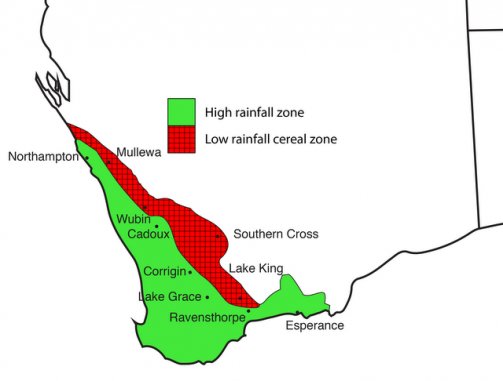In Western Australia, there are two main ‘worm control’ zones within the winter rainfall region. Both have a typical Mediterranean-type climate, defined by hot, dry summers and cool, wet winters. The major difference between the zones is in regard to the amount and duration of winter rainfall, and the boundaries for these zones are only approximate as seasonal temperatures and rainfall variations affect worm development.

This includes the corner of the state, south-west of the 350 mm rainfall isohyet. It starts at the coast a little north of Kalbarri, continues west of Mullewa and Perenjori, then includes Cadoux, Quairading, Corrigin, Lake Grace, Ravensthorpe, and Esperance near its eastern or northern edge.
The total rainfall and seasonal duration (months of rainfall) is greater in this zone. Conditions for worm burden development are therefore more favourable than in drier areas.
There is a large variation between districts in this zone in the annual risk of significant worm problems due to rainfall differences, although the basic control plan is applicable. The worm risk is lower east of the 500 mm isohyet, where there is usually a shorter pasture growth season and a greater area of the farm is under crop.
Closer to the coast within the zone the rainfall is considerably higher, and pastures often retain a green component over summer (a barber’s pole worm risk). Along the south coast and west of Bremer Bay, and in a coastal zone along the west coast as far as Geraldton, the rainfall is both greater and of longer seasonal duration, further increasing the likelihood and duration of the worm risk.
The Low Rainfall Cereal Zone
This zone is generally east of the 350 mm isohyet. In these areas the summers are hot and the effective rainfall is relatively low. As cropping is the dominant enterprise, the large areas of crop stubbles provide significant opportunities to avoid worm intake. The worm risk is therefore low in most years, and especially in eastern areas of the zone, visible signs of worms are only occasionally seen after unusually heavy summer rainfall.
The most important roundworms in this region are:
In areas where sufficient summer rainfall occurs to maintain perennial pastures (mostly within 40 km of the coast):
Higher burdens of all worms are likely in very wet years. These can be fatal with or without scouring occurring.
Gastro-intestinal parasites of minor importance such as tapeworms are not covered. Liver fluke does not occur in Western Australia.